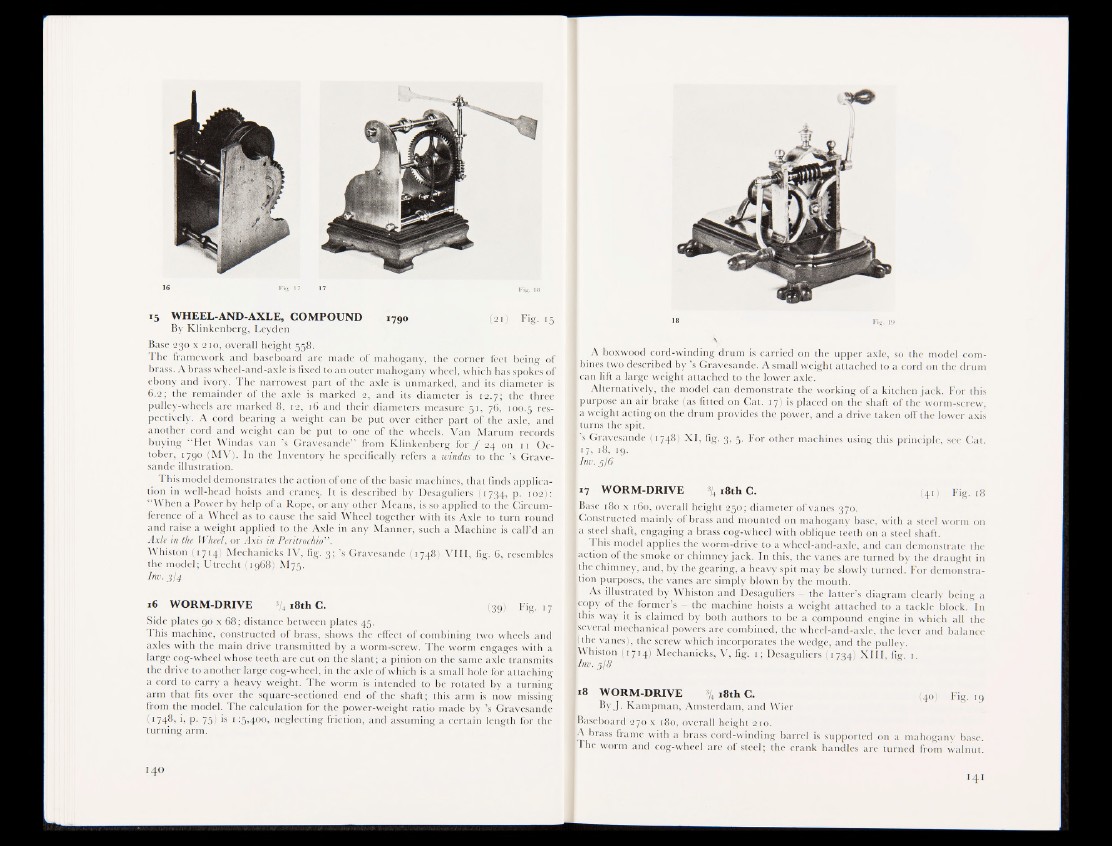
15 WHEEL-AND-AXLE, COMPOUND 1790 ; | 2i) Fig. 15
By Klinkenberg, Leyden
Base 230 x 210, overall height 558.
The framework and j3aseboarf|are made of mahogany, the corner feet beingtof
brass. A brass wheel-and-axle is fixed to an outer mahogany wheel, which has spokes of
ebony and ivory. The narrowest part of the axle is unmarked, and its diameter is
6.2; the remainder of the axle is marked 2, and its diameter is 12.H the three
pulley-wheels are marked 8, 12, 1 b and their diameters measure 51, 76, 100.5 respectively.
A cord bearing a weight can be put over either part ofspte axle, and
another cord and weight can be put to one of the whee%,Van Marua» records
buying “ Het Windas van ’s Gravesande” from Klinkenberg for / 24 on 11 October,
1790 (MV). In the Inventory he specifically refers a windas to the ’s Grave-
sand e illustration.
This model demonstrates the action of one of the basic machines, that finds application
in well-head hoists and cranes. It is described by Desaguliers (1734, p. 102,)'+.,
“When a Power by help of a Rope, or any other Means, is so applied to the Circumference
of a Wheel as to cause the said Wheel together with its Axle to turn round
and raise a weight applied to the Axle in any Manner, such a Machine is bail'd an
Axle in the Wheel, or Axis in Peritrochiow.
Whiston (1714) Mechanicks IV, figj.3; ’s Gravesande (1.748) VIII, fig. 6, resembles
the model; Utrecht (1968) M75.
Inv. 3I4
16 WORM-DRIVE % 18th C. ^4-39) Fig- U
Side plates 90 x 68; distance between plates 45.
This machine, constructed of brass, shows the effect of combining two wheels and
axles with the main drive transmitted by a worm-screw. The worm engages with a
large cog-wheel whose teeth are cut on the slant; a pinion on the same axle transmits
the drive to another large cog-wheel, in the axle of which is a small hole for attaching
a cord to carry a heavy weight. The worm is intended to be rotated by a turning
arm that fits over the square-sectioned end of the shaft; this arm is now missing
from the model. The calculation for the power-weight ratio made by ’S Gravesande
(1748, i, p. 75) is 1 :5,4O0, neglecting friction, and assuming a certain length for the
turning arm.
| A boxwood cord-winding drum is carried on the upper axle, so the model com-
Ibines two described b y ’s Gravesande. A small weight attached to a cord on the drum
lean lift a large weight attached to the lower axle.
Alternatively, the model can demonstrate the working of a kitchen jack. For this
I purpose an air brake (as fitted on Cat. 17) is placed on the shaft of the worm-screw,
la weight acting on the drum provides the power, and a drive taken off the lower axis
turns the spit.
|!s Gravesand®I|i748) XI, fig. 3, g. For other machines using this principle, see Cat.
I 17, l8, ! 9.
Inv. 5/6'
17 WORM-DRIVE V4 18th C. (4i) Fig. 18
Base 180 x 160, overall height S§o; diameter of vanes 370.
IConstructed mainly of brass and mounted on mahogany base, with a steel worm on
|a|Seel shaft, engaging a brass cog-wheel with oblique teeth on a steel shaft.
This model applies the worm-drive to a wheel-ahd-axle, and can demonstrate the
fection of the smoke or chimney jack. In this, the vanes are turned by the draught in
the chimney, and, by the gearing, a heavy spit may be slowly turned. For demonstration
purposes, the vanes are simply blown by the mouth.
As illustrated by Whiston and Desaguliers - the latter’s diagram clearly being a
jeopy of the former’s - the machine hoists a weight attached to a tackle block. In
tljjg way it is claimed by both authors to be a compound engine in which all the
•several mechanical powers are combined, the wheel-and-axle, the lever and balance
[(the vanes)., the screw which incorporates the wedge, and the pulley.
Whiston (1714) Mechanicks, V, fig. 1; Desaguliers (1734) XIII, fig. 1.
\lnv. jjg
*8 WORM-DRIVE % 18th C. (40) Fig. 19
ByJ. Kampman, Amsterdam, and Wier
Baseboard 270 x 180, overall height 210.
A brass frame with a brass cord-winding barrel is supported on a mahogany base.
The worm and cog-wheel are of steel; the crank handles are turned from walnut.